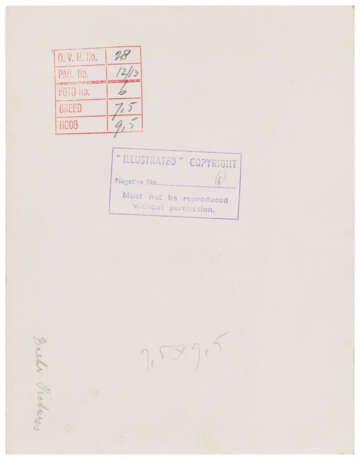ID 1029159
Lot 508 | Bebop in Britain: 5 photographs
Estimate value
£ 1 000 – 1 500
Five vintage black and white press photographs of dancers at Club Eleven, London, c.1949, the candid images conveying the frenzied energy of the multi-racial audience and fervid atmosphere of the short-lived Soho nightclub at the heart of the bebop movement in Britain.
Club Eleven, named after its eleven founder members, opened at 41 Great Windmill Street in Soho in 1948, with its two house bands - one led by Ronnie Scott and the other by John Dankworth – playing on Thursday and Saturday nights. The club’s popularity demanded a move to larger premises at 50 Carnaby Street, where the club now operated six nights a week. A police raid on the night of 15 April 1950 saw six musicians arrested on drug charges and sealed the demise of the club. Saxophonist Don Rendell remembered ‘It was a rough place - a kind of old ramshackle sort of bare room with lightbulbs. The big room right at the back had some old settees, very dingy. There was no effort to beautify the place, none. It was entirely the music that filled it. Some nights it really did fill it. The interest in jazz was growing, but the point was, it was the in place. It was the hip place. There was a dance floor… Those days were shrouded, almost completely enveloped in a marijuana haze. No wonder no one can remember them… the people didn't seem baffled at all by the new music we were playing. It seemed to be so obviously right. What we were hearing on record from Parker, Gillespie, the early Miles Davis, tenor players like Wardell Gray, Dexter Gordon, Stan Getz and Allan Eager - we just fell naturally into it. And the audiences just lapped it up’. Grime, 47.
The images by Baehr Pictures, Amsterdam, for Illustrated magazine, vintage gelatin silver press prints, each with stamped publisher’s credit and pencil notations verso, the largest 240 x 192 mm.
| Address of auction |
CHRISTIE'S 8 King Street, St. James's SW1Y 6QT London United Kingdom | ||||||||
|---|---|---|---|---|---|---|---|---|---|
| Preview |
| ||||||||
| Phone | +44 (0)20 7839 9060 | ||||||||
| Buyer Premium | see on Website | ||||||||
| Conditions of purchase | Conditions of purchase |








